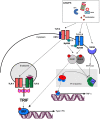Trauma-Induced Damage-Associated Molecular Patterns-Mediated Remote Organ Injury and Immunosuppression in the Acutely Ill Patient
- PMID: 29963048
- PMCID: PMC6013556
- DOI: 10.3389/fimmu.2018.01330
Trauma-Induced Damage-Associated Molecular Patterns-Mediated Remote Organ Injury and Immunosuppression in the Acutely Ill Patient
Abstract
Trauma is one of the leading causes of death and disability in the world. Multiple trauma or isolated traumatic brain injury are both indicative of human tissue damage. In the early phase after trauma, damage-associated molecular patterns (DAMPs) are released and give rise to sterile systemic inflammatory response syndrome (SIRS) and organ failure. Later, protracted inflammation following sepsis will favor hospital-acquired infection and will worsen patient's outcome through immunosuppression. Throughout medical care or surgical procedures, severe trauma patients will be subjected to endogenous or exogenous DAMPs. In this review, we summarize the current knowledge regarding DAMP-mediated SIRS or immunosuppression and the clinical consequences in terms of organ failure and infections.
Keywords: critical care; damage-associated molecular pattern; hospital-acquired infection; posttraumatic immunosuppression; remote organ dysfunction; transfusion.
Figures



References
-
- Bone RC, Balk RA, Cerra FB, Dellinger RP, Fein AM, Knaus WA, et al. Definitions for sepsis and organ failure and guidelines for the use of innovative therapies in sepsis. The ACCP/SCCM Consensus Conference Committee. American College of Chest Physicians/Society of Critical Care Medicine. Chest (1992) 101:1644–55.10.1378/chest.101.6.1644 - DOI - PubMed
Publication types
LinkOut - more resources
Full Text Sources
Other Literature Sources

